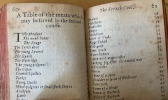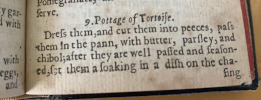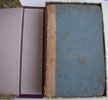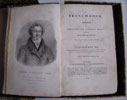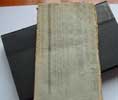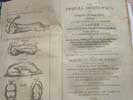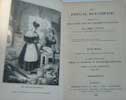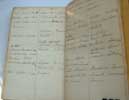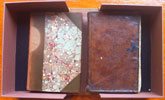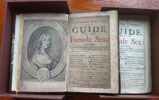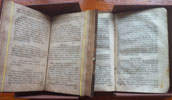THE FORME OF CURY.
A ROLL OF ANCIENT COOKERY, Compiled, about A.D. 1390, by the Master-Cooks of King Richard 11, Presented afterwards to Queen Elizabeth, by Edward Lord Stafford, And now in the Possession of Gustavus Brander, Esq. Illustrated with NOTES, And a copious INDEX, or GLOSSARY. A MANUSCRIPT of the EDITOR, of the same Age and Subject, with other congruous Matters, are Subjoined. "---ingeniosa gula est." MARTIAL LONDON PRINTED BY J. NICHOLS, PRINTER TO THE SOCIETY OF ANTIQUARIES. M DCC LXXX.
FIRST EDITION - 1st ISSUE. 1780. InSide the green cover, bookplate of Crosby Giage. 1fep. [1] On verso the Frontispiece with a nice ornate illustration of Samuel Pegge. [1] iii-iv dedication from Brander to Pegge. i - xxx Preface. [1] 1page facsimile of the manuscript. xxxi - xxxvi. 1-161 The Forme of Cury. 162 Addenda. 163-164 Advertisement. 163-188 Rolls of Provisions. 2feps. Quarter red red leather with red marbled boards. Spine with gilt lines on raised bands. Gilt title and date. Internally test block and pages in fine clean condition.
- The Forme of Cury (The Method of Cooking) is an extensive collection of medieval English recipes from the 14th century. Originally in the form of a scroll, compiled and listed as "the chief Master Cooks of King Richard II". It is among the oldest English cookery texts, and the first to mention olive oil, gourds, and spices such as mace and cloves. The scroll was written in late Middle English (c. 1390) on vellum and contains about 200 recipes (although the exact number of recipes varies slightly between different versions) with many of the same recipes as 'Ancient Cookery' (Latin: Diuersa seruicia). 'The Forme of Cury' may have been written partly to compete with 'Le Viandier' of Taillevent, a French cookbook created around the same time. This supports the idea that banquets were a symbol of power and prestige for medieval lords and kings. The name, 'The Forme of Cury' was given by Samuel Pegge, who published this edition of the manuscript in 1780 for the curator of the British Museum, Gustavus Brander. The title has come to be used for almost all versions, although they differ from each other. It is one of the best-known medieval guides to cooking. The Forme of Cury’ is the first English text to mention olive oil, cloves, mace and gourds in relation to British food. Most of the recipes contain what were then luxurious and valuable spices: caraway, nutmeg, cardamom, ginger and pepper. There are also recipes for cooking strange and exotic animals, such as whales, cranes, curlews, herons, seals and porpoises. Some of the food and spices could have only come to England through trade from Muslim lands. In 2009 another variant of 'The Forme of Cury' from about the same time, but in codex form, was discovered in the John Rylands Library at Manchester University. Samuel Pegge the elder, born 5 November 1704, was an English antiquary and clergyman. Besides the 'Forme of Cury' he wrote seven memoirs in the Bibliotheca Topographica Britannica, including The Story of Guy, Earl of Warwick (1783); The History of Eccleshall Manor (1784); The Roman Roads of Derbyshire (1784);[4] The Textus Roffensis (1784) ; History of Bolsover and Peak Castles, Derbyshire (1783). He also wrote a large number of articles for the Gentleman's Magazine from 1746 to 1795, He died, after a fortnight's illness, on 14 February 1796 at age 92. He was buried in the chancel at Whittington, where a mural tablet was installed.
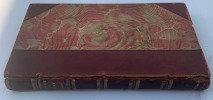





click on image to enlarge

Antiquarian category
ref number:
11250 


